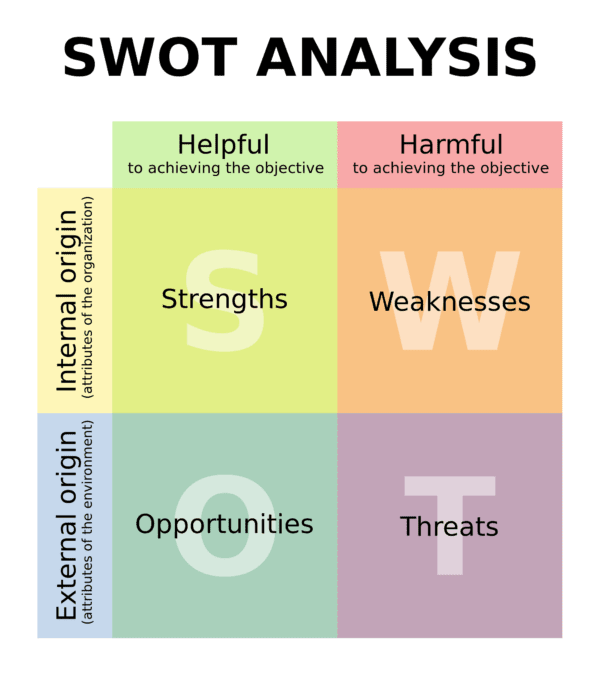
SWOT analysis is a tool for business decision making. It was originally proposed by Edmund P Learned et al. in the 1969 book “Business Policy, Text and Cases” SWOT is an acronym for Strengths, Weaknesses, Opportunities and Threats.
The principle of a SWOT analysis is simple; it helps someone weigh up the internal and external factors which may affect the outcome of a decision. If you want to guide your business through a complex decision – SWOT is a very simple way to take account of the variables involved in the decision.
What Sort of Decisions Should SWOT Be Used For?
You don’t need to use SWOT for every decision that you make in the business. It’s perfectly OK to decide on small things without extended analysis or you’ll get bogged down in process rather than getting things done. However, if you’ve got a strategic decision to make such as deciding on a new marketing initiative or examining particular business functions for change then a SWOT analysis can be a lifesaver.
Tim Berry, writing for Bplans says; “Existing businesses can use a SWOT analysis, at any time, to assess a changing environment and respond proactively. In fact, I recommend conducting a strategy review meeting at least once a year that begins with a SWOT analysis.
New businesses should use a SWOT analysis as a part of their planning process. There is no “one size fits all” plan for your business, and thinking about your new business in terms of its unique “SWOTs” will put you on the right track right away, and save you from a lot of headaches later on.”
Who Should Conduct a SWOT Analysis?

A SWOT analysis doesn’t have to be a one-man or woman effort. While it’s fine for a business owner to carry out a SWOT analysis in isolation when they’re trying to do something that requires nobody else’s input; it’s equally OK to bring together a team of people (perhaps those involved in the area which the strategic plan is for) to help flesh out the elements of a SWOT analysis too. Because it’s a simple tool to use – it won’t take long to bring people up to speed.
How to Carry Out a SWOT Analysis
A SWOT analysis is very simple to carry out. You begin by creating a table, like the one a little bit farther down the page, split into two rows and two columns – creating four squares. Each square is then married to one of the elements of a SWOT analysis; Strengths, Weaknesses, Opportunities and Threats.
It’s important to note that there shouldn’t be an overlap between strengths and opportunities and weaknesses and threats because one looks inside of the organization and the other looks outside of it. However, there may be a correlation between the two pairings and if you discover an external threat which strongly correlates to an internal weakness – that may be something that you want to address because it demonstrates one of the highest levels of risk that your business faces.
Internal Factors – Strengths and Weaknesses

Strengths and Weaknesses are used to examine factors that are internal to the organization that is – the resources, skills, experience, etc. that you already have (or don’t have in the case of weaknesses). To get this process right, you must be completely honest, there’s no point in pretending that a weakness doesn’t exist or that you’re strong at something that you’re not. The SWOT analysis is designed to help you to take action on these things.
Examples of internal factors:
- Human resources – this might include people employed by the business, the people who are going to use your product/service, etc.
- Intellectual property – ownership of patents, copyrights, trademarks, etc.
- Technical resources – hardware, software, etc.
- Financial resources – cash on hand, grant opportunities, alternative sources of income, etc.
External Factors – Threats and Opportunities
External factors are the factors in the decision which lay outside of the businesses control. If you find, for example, a lack of skill in the business; you can hire someone or train someone and thus that’s within your control and is an internal factor. Whereas a recession in your country is an economic factor over which you have no control and it’s an external factor.
Examples of external factors:
- Trends in the market such as technological shifts or change in consumer demand, etc.
- Political changes such as changes in taxation or grant allocation
- Supplier’s internal change mechanisms – for example introducing or withdrawing a component for production
- Environmental changes – from global warming to a flash flood
An Example of a SWOT Analysis
Our SWOT analysis example is designed to give you a template to operate from; each SWOT analysis will be unique to your business and your current situation – so this should provide inspiration rather than something to copy.
| Strengths | Weaknesses |
| Recruitment consultant with trained and experienced staff within the banking sector
Medium sized with 40 employees not so big that we can’t implement rapid change as necessary |
We lack people with experience in other forms of accountancy recruitment
We’ve had some minor success in other forms of accountancy recruitment but we’re punching below our weight |
| Opportunities | Threats |
| There is a huge range of businesses needing qualified accountants and we have a large talent pool to draw from
There are very few across the board accounting recruitment firms in our area |
Larger firms might move into the area or a new recruitment firm might form in response to the need
There’s a growing resistance to using recruitment consultant in the banking sector |
Outcome: To broaden our practice to target other accounting professionals outside of banking. To hire some staff with experience in these areas and use their expertise to cross-train existing staff.
Other Decision Making Tools
There are many other forms of business decision making tool and you should always use the right tool for the right job. Some of these tools include:
PESTLE Analysis which examines the political, economic, social, technological, legal and environmental factors surrounding a decision.
Pareto Analysis which uses an 80/20 rule to determine business priorities
Grid Analysis which is a slightly more complex tool for examining variables
